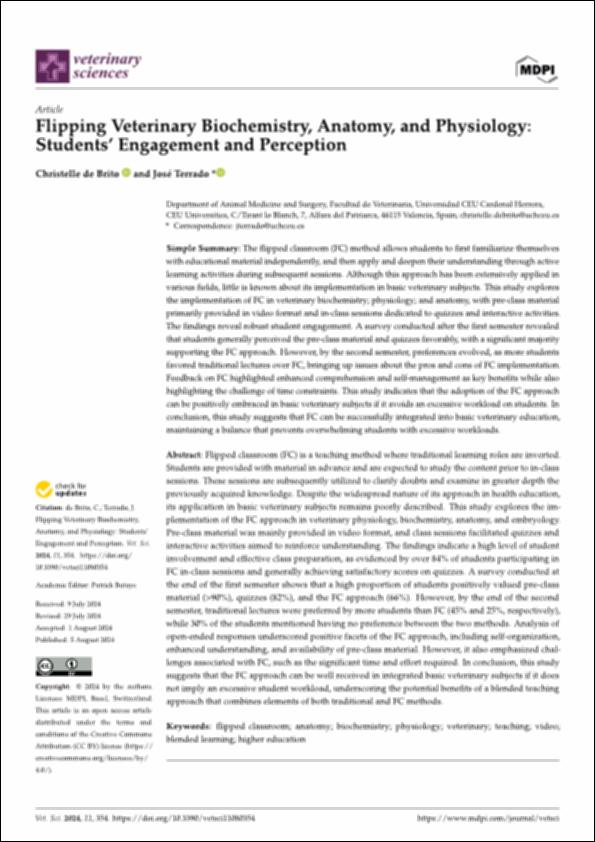Please use this identifier to cite or link to this item:
http://hdl.handle.net/10637/16104Flipping veterinary biochemistry, anatomy, and physiology: students’ engagement and perception
| Title: | Flipping veterinary biochemistry, anatomy, and physiology: students’ engagement and perception |
| Authors : | De Brito, Christelle Terrado Vicente, José |
| Keywords: | Enseñanza universitaria; Higher education; Método de enseñanza; Teaching methods; Veterinaria; Veterinary medicine; Anatomía; Anatomy; Fisiología; Physiology; Bioquímica; Biochemistry |
| Publisher: | MDPI |
| Citation: | De Brito, C. & Terrado, J. (2024). Flipping veterinary biochemistry, anatomy, and physiology: students’ engagement and perception. Veterinary Sciences, vol. 11, i. 8 (05 aug.), art. 354. DOI: https://doi.org/10.3390/vetsci11080354 |
| Abstract: | Flipped classroom (FC) is a teaching method where traditional learning roles are inverted. Students are provided with material in advance and are expected to study the content prior to in-class sessions. These sessions are subsequently utilized to clarify doubts and examine in greater depth the previously acquired knowledge. Despite the widespread nature of its approach in health education, its application in basic veterinary subjects remains poorly described. This study explores the implementation of the FC approach in veterinary physiology, biochemistry, anatomy, and embryology. Pre-class material was mainly provided in video format, and class sessions facilitated quizzes and interactive activities aimed to reinforce understanding. The findings indicate a high level of student involvement and effective class preparation, as evidenced by over 84% of students participating in FC in-class sessions and generally achieving satisfactory scores on quizzes. A survey conducted at the end of the first semester shows that a high proportion of students positively valued pre-class material (>90%), quizzes (82%), and the FC approach (66%). However, by the end of the second semester, traditional lectures were preferred by more students than FC (45% and 25%, respectively), while 30% of the students mentioned having no preference between the two methods. Analysis of open-ended responses underscored positive facets of the FC approach, including self-organization, enhanced understanding, and availability of pre-class material. However, it also emphasized challenges associated with FC, such as the significant time and effort required. In conclusion, this study suggests that the FC approach can be well received in integrated basic veterinary subjects if it does not imply an excessive student workload, underscoring the potential benefits of a blended teaching approach that combines elements of both traditional and FC methods. |
| Description: | Este artículo pertenece a la sección "Veterinary Education, Veterinary Communication and Animal Behavior". |
| URI: | http://hdl.handle.net/10637/16104 |
| Rights : | http://creativecommons.org/licenses/by/4.0/deed.es Open Access |
| ISSN: | 2306-7381 (Electrónico) |
| Issue Date: | 5-Aug-2024 |
| Center : | Universidad Cardenal Herrera-CEU |
| Appears in Collections: | Dpto. Medicina y Cirugía Animal |
Items in DSpace are protected by copyright, with all rights reserved, unless otherwise indicated.


